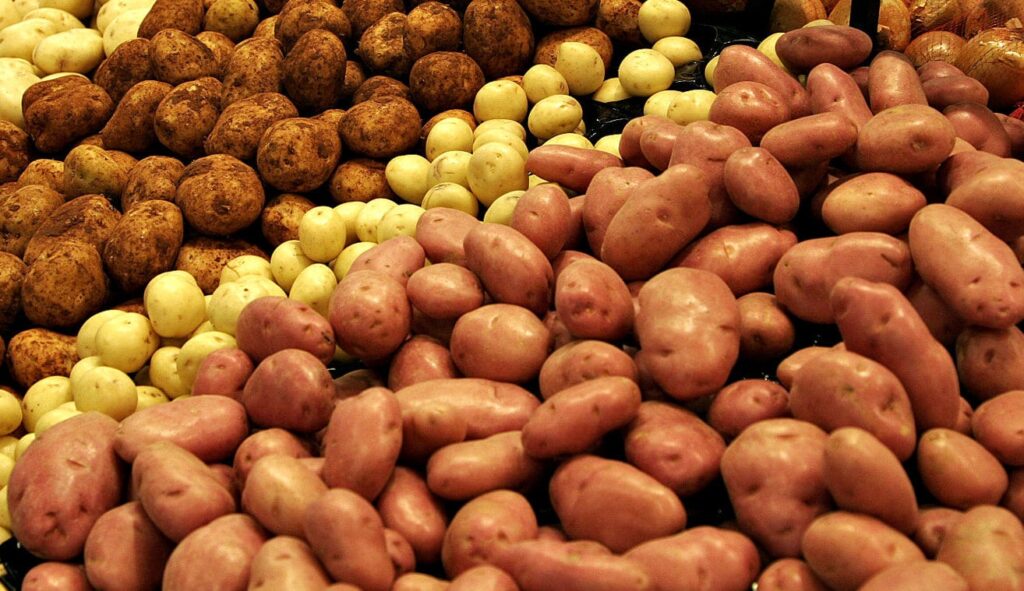The most important pest of the potato crop
The potato tuber moth (in English: Potato tuber moth) is the most widespread insect in the world, it is found in North Africa, parts of Asia, Europe, Oceania, and the Americas, and it has many species, and this insect attacks potato crops leaving transparent blisters in the leaves due to absorption The minerals from them are by the larvae, then the blisters are transferred to the trunk, which causes the death of the plant, and the tubers can also be deformed through the access of the larvae to them by hatching the eggs spread on the leaves, or by the fall of the larvae to the ground and digging cracks in the soil through which the tubers are reached Or, by placing eggs directly on or near the open tubers, and when these eggs hatch and turn into larvae, they dig tunnels inside the tubers, forming the entrance to several diseases such as sepsis. [10] The potato tuber mite pest can be prevented by following the following instructions: [10] Avoid planting seeds or tubers that were infested by the potato tuber moth. Cultivation of tubers at an appropriate depth, and the need to cover them with soil and avoid leaving them exposed. Avoid planting in areas that have suffered from soil erosion in previous seasons, as erosion will make the tubers exposed, creating opportunities for the potato tuber moth to lay eggs on them. Ensure that the deep soil is free of cracks resulting from various agricultural practices such as irrigation, in order to prevent the potato tuber moth from laying its eggs on the tubers. Water the crop in small quantities each time to avoid loosening of the soil, and to harvest the tubers as soon as the crust forms. Avoid leaving the potato tubers in containers until the next morning, in addition to avoiding digging the soil around the tubers and leaving them for the next day for the tubers to be collected and stored, as the female potato tuber moth is more active in laying eggs in the evening. Do not use plant covers, as the worm will transfer from it to the tubers as soon as it wilts. The need to get rid of the remains of livestock. Do not use tubers of unknown source. The use of insecticides designated for potato tuber moths, and some of these pesticides can be used at the beginning of the season, and some are used at the end of the season when the tubers ripen, and some of these types are used when the tuber mites are adults or the larvae are present in the leaf tissue and some are used when they are The tuber moth is an adult and the larvae are not present in the leaf tissue, and there are also species specific to the Manzi gardens.
Cutworm
Cutworms are spread all over the world, they are found in Europe, Canada, the United States, Japan, South Africa, South America, and New Zealand, and this insect feeds on seedlings located at the level of the soil surface, and has the ability to pull plants to the places of their holes, and these are found The worm is also in the roots, so it feeds on the roots or the lower ground stalk, causing many damages in the evening times. These worms are present in huge numbers, which makes eliminating them difficult, and their locations under soil or under tree leaves may prevent pesticides from reaching them, in addition to that adult worms become more resistant to insecticides. [11]
A number of steps must be taken to prevent cutworms, as follows: [11]
Ensure that there are no worms in the areas to be cultivated before starting the planting process, and often the areas that were previously exposed to the spread of worms in them are more vulnerable to infection than others. Disposal of removed weeds, weeds, and crop residues; Because they are good places for worms to spread. Monitor the crop continuously and make sure that there are no wilted plants partially or completely, and if there are wilted plants, they are removed and digging around their base, then sifting the soil to get rid of the larvae, and this process is done in the evening or at dawn. Plowing the soil to a depth suitable for the exit of the larvae to the surface of the earth to be disposed of by sunlight or the animals that feed on it. Using sprays to spray insecticides of large size, directing them directly on the rows of the plants, and taking into account the access of the pesticides to the running water on the soil. Choose the right time to spray the insecticide, so that it is while feeding the larvae on the leaves of the plant or when they are on the surface of the soil. Placing the larvae vaccinated with insecticides before the crop appears.
Potato leaf bouncy
The potato leaf hopper is longitudinal in shape with a bright green or yellowish green color, and white spots spread on the insect’s head and its rib cage, and it has two transparent green wings, while the caterpillar resembles an adult insect, but with a smaller size and without wings, this insect gnaws at the tips of the leaves of plants and feeds Directly on its sap, which leads to its fall, and the symptoms of potato infestation with this insect begin with the appearance of yellowing with slight curvature at the site of the necrosis, then it turns brown and expands until all the leaves die or dry, which affects the destruction of the entire crop, [12] and this can be prevented. The insect through constant monitoring of the leaves and treatment of the infected person, and being aware that some types of insecticides also kill the leaves, so they must be avoided.
![]()

